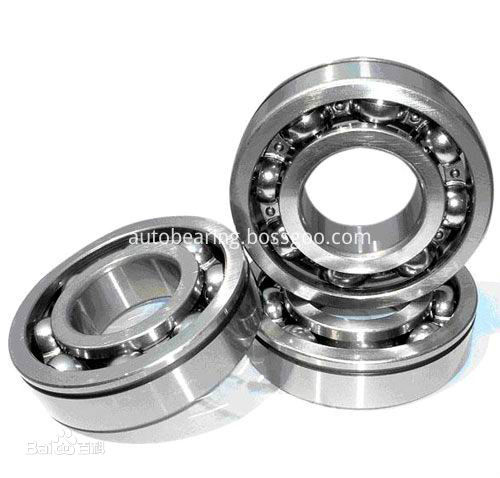Deep Groove Ball Bearing,
formerly known as single-row centripetal ball bearing, is the most widely used
rolling bearing. It is characterized by small frictional resistance and high
speed, which can be used to bear the combined load of radial load or radial
direction and axial load, and also can be used to bear the axial load.
The basic type deep groove
ball bearing consists of an outer ring, an inner ring, a set of steel balls and
a set of cage. .Deep groove ball bearing type has a single row and double row
two kinds, deep groove ball structure is sealed and open two kinds of
structure, open type means without seal, seal type deep groove ball bearing
also have dust seal and oil seal. The dustproof sealing material is sheet metal
stamping, only simple to prevent the dust from entering the bearing raceway. The
oil-proof type is contact oil seal, which can effectively prevent the grease out
of the bearing.
Deep groove ball bearing type:
deep groove ball bearing
(60000 type);
Deep groove ball bearing with
stop groove in outer ring (60000N type);
Deep groove ball bearing with
a dustproof cover and a stop groove on the other side.(60000-ZN type)
Deep groove ball bearing double
cover with dustproof cover and with stop groove in outer ring (60,000-2zn type);
Deep groove ball bearing with
dust cover (60000Z);
Deep groove ball bearing with
dust cover on both sides (60,000-2z);
Deep groove ball bearing with
seal (60,000-ls type, 60,000-rz type);
Deep groove ball bearing with
seals on both sides (60,000-2ls, 60000-2rz);
Deep groove ball bearing with
flange (F60000 type);
Deep groove ball bearing with flange
andone side dust cover(F60000-Z type).
Deep groove ball bearing with flange
and both sides dust cover.(F60000-2Z).
Application:
Deep groove ball bearing can
be used for gearbox, instrument, motor, household electric appliance, internal
combustion engine, transportation vehicle, agricultural machinery, construction
machinery, construction machinery, roller skating shoes, yo-yo-ball, etc.
We believe that we can supply
the best service and price for your, hope to make a long-term cooperation with
you. If you have any question please do not hesitate contact with us. We keep
warmly welcome you visit us in any time.
Deep Groove Ball Bearing Deep Groove Ball Bearing,Wholesale Deep Groove Ball Bearing,High Precision Deep Groove Ball Bearing,Stainless Steel Deep Groove Ball Bearing LUOYANG AUTO BEARING CO.,LTD , https://www.ballbearing.nl
2MS+30 2 ==== 2M0+2S0 2 (1)
2S0 2 +O 2 â†â†’ 2SO 3 (2)
MO+SO 3 â†â†’ MSO 4 (3)
In the oxidative calcination, the reaction (1) of the metal sulfide and the sulfur dioxide is irreversible, and the formulas (2) and (3) are reversible.
In the roasting process, when the partial pressure of sulfur trioxide in the furnace gas is greater than the decomposition pressure of the metal sulfate, the calcined product is a metal sulfate, and the process is a sulfurization roasting. on the contrary. When the partial pressure of sulfur trioxide in the furnace gas is less than the decomposition pressure of the metal sulfate, the calcined product is a metal oxide (fully desulfurized roasting). Therefore, the sulfide oxidized octomerization product at a certain temperature depends on the gas phase composition and the dissociation pressure of the metal sulfide, oxide and metal sulfate. The decomposition temperature and decomposition free energy of various metal sulfates are different. By controlling the calcination temperature and the composition of the furnace gas, the composition of the calcined product can be controlled to achieve the purpose of selecting the sulfated calcination.
Roasting of sulfides such as sulfides of copper during copper is
550 °C
2CuFeS 2 ======= Cu 2 S+2FeS+S
400 °C
2CuS ====== Cu 2 S+S
200~300 °C
2Cu 2 S+5O 2 ========= 2Cu0+2CuS0 4
300 °C
Cu 2 S+20 2 ======2Cu0+SO 2
>1000 °C
4Cu0 ======= 2Cu 2 0+0 2
1 <650 °C
SO 2 +——0 2 ======= SO 3
2
<650 °C
Cu0+SO 3 =======CuSO 4
When sulfide is present, the copper sulfate formed by the reaction will react with each other at a very low temperature to decompose:
100 °C
CuSO 4 +3CuS ======= 2Cu 2 S+2S0 2
300~400 °C
2CuS0 4 +Cu 2 S}===========2Cu 2 0+3SO 2
Therefore, the temperature of copper sulphation roasting should be less than 65,090, and the temperature of oxidizing roasting should be higher than 650 cC. At this time, the calcined products are mainly unoxidized cuprous sulfide, copper oxide and a small amount of copper sulfate.
What is the basic principle of oxidative roasting and sulphation roasting?
Heating in an oxidizing atmosphere in the sulfide ore, the ore all (or part of) the sulfur removal converted into the corresponding metal oxide (or sulfate) in the process, referred to roasting (calcination or sulfated) process. Under calcination conditions, the reaction formula for the conversion of sulfide minerals to metal oxides and metal sulfates can be expressed as: